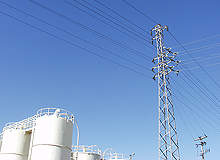
The Abu Dhabi Gas Industries (GASCO) Integrated Gas Development (IGD) project aims to develop onshore and offshore gas processing facilities in Habshan and Ruwais, Abu Dhabi. GASCO is a unit of the Abu Dhabi National Oil Company (ADNOC) and deals with its gas projects.
The facilities developed by the IGD project transport gas to the Umm Shaif field to be processed in Habshan and Ruwais. The Integrated Gas Development programme was completed in 2013.
The programme was undertaken to provide a natural gas supply to consumers in Abu Dhabi and meet their growing demand for energy. It also links the onshore and offshore facilities of companies operating under ADNOC.
Phase one of the Integrated Gas Development Expansion (IGD-E) project was launched in 2015 and was completed in August 2018. The first phase of the IGD-E project increased ADNOC’s offshore gas processing capacity from 400mmcfd (million cubic feet a day) to 1.4 bcfd (billion cubic feet a day).
ADNOC signed an engineering, procurement and construction (EPC) contract worth AED3.16bn ($860m) with a consortium of Spanish Técnicas Reunidas and Abu Dhabi-based Target Engineering Construction Company for the development of the second phase of the IGD-E project in September 2018.
Construction and infrastructure of Integrated Gas Development programme
The project components included a new complex called Habshan 5 located 15km northeast of GASCO’s existing complex in Habshan. The complex also features a gas processing facility, a natural gas liquids (NGL) recovery unit, four sulphur recovery units and utilities, and offsite facilities.
The gas processing facility includes four gas processing trains with a total capacity of 2,000m standard cubic feet per day (mscfd). The sulphur recovery units have a recovery efficiency of 99.9%, which cut down emissions and conforms to the environment standards of ADNOC.
As part of the project, facilities were added to GASCO’s existing plant at Ruwais. These facilities include a new NGL train with a capacity of 27,000t/d of NGL and liquefied petroleum gas (LPG). Six cryogenic LPG storage tanks (three propane and three butane) with a capacity of 110,000m3 were also installed at the Ruwais plant.
In addition, two ambient paraffin naphtha storage tanks with a capacity of 90,000m³ were added.
Approximately 90% of the work on the processing plant was completed by 2012.
Integrated Gas Development Expansion (IGD-E) details
Phase one of the expansion project was carried out in three packages. The first package included the construction of a fourth gas dehydration unit and dry gas compression aftercooler on Das Island.
The second package included a 117km offshore segment along the new 42in IGD-E pipeline which runs from Das Island to the pipeline corridor shore crossing tie-in at Ras Al Qila, and a 114km onshore segment that continues from Ras Al Qila parallel to the existing 30in OAG pipeline to a point near Habshan.
The third package of phase one involved the construction of onshore pipelines and Habshan modifications located at Das Island in Abu Dhabi.
Phase two of the IGD-E project will add 245mmcfd of associated gas to the 1.4bcfd of offshore gas sent from Das Island to ADNOC Gas Processing’s Habshan gas facilities.
It also includes the construction and commissioning of new gas facilities on Das Island, which will consist of a new Booster Compression Train with a capacity of 60mmcfd, and two Feed Gas Compression and Dehydration Trains with 80mmcfd capacity each.
Contractors
Fluor was awarded the Front End Engineering and Design (FEED) contract for the project. The company completed the FEED study in July 2008.
In May 2007, KBR was awarded a contract for providing project management for the onshore and offshore facilities of the Habshan complex. The contract was valued at $30m.
In July 2009, GASCO awarded engineering, procurement, construction and commissioning (EPCC) contracts for various components of the project. A joint venture, formed between Japan’s JGC Corporation and Italy’s Maire Tecnimont, was awarded the EPCC contract for the Habshan 5 processing facility, sulphur recovery units and NGL recovery unit. The total value of the contract is $4.7bn.
Tecnimont and Abu Dhabi Gas Liquefaction Company (ADGAS) were awarded a $225m contract for the development of the first package of the IGD Expansion Project (IGD-E).
JGC and Technimont subcontracted Kuwait-based Kharafi National for the construction of the processing facility. The contract is valued at $728m. The JV also awarded a $13.8m sub-contract to Abu Dhabi-based Ducab to supply power cables for the project.
In August 2010, JGC and Technimont awarded a contract to Elliott Group to provide 16 compressor trains for the processing facility. Elliot is expected to deliver the compressor trains towards the end of 2012.
Hyundai Engineering & Construction won the $1.7bn EPC contract for Habshan utilities and offsite facilities.
Hyundai awarded a subcontract worth $200m to GE Oil & Gas to supply eight gas turbines for the Habshan 5 processing plant. The turbines provide 250MW of power for the plant. They feature advanced dry low NOx combustors for emissions control and other equipment.
An EPC contract worth $2.1bn for the new NGL train at Ruwais was awarded to a JV between UAE’s Petrofac and South Korea’s GS Engineering. The JV subcontracted Target Engineering Construction for installing a sea water cooling system for the NGL train. Under the $129.5m subcontract, Target carried out the design, engineering and installation of the sea water system.
Chicago Bridge & Iron (CB&I), a company based in the US, was awarded a $5.033bn contract for constructing the storage tanks at Ruwais. Scope of work for CB&I include engineering, procurement and fabrication of the six LPG tanks and two paraffin naphtha tanks. CB&I will also be responsible for piping, controls and other civil works.
Integrated Gas Development Program project output
Currently, the complex has a capacity of 900mmscfd of natural gas, 12,000t/d of NGL and 5,000t/d of liquid sulphur.
Propane, butane, paraffinic naphtha and sulphur produced at Ruwais are being exported. Ethane is also being supplied as feedstock to the Borouge Petrochemical Complex.

